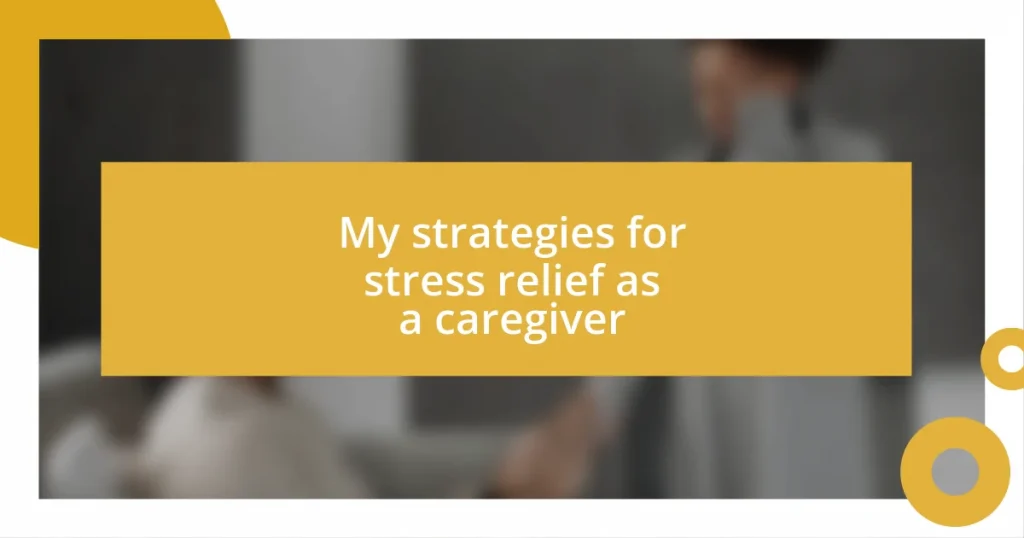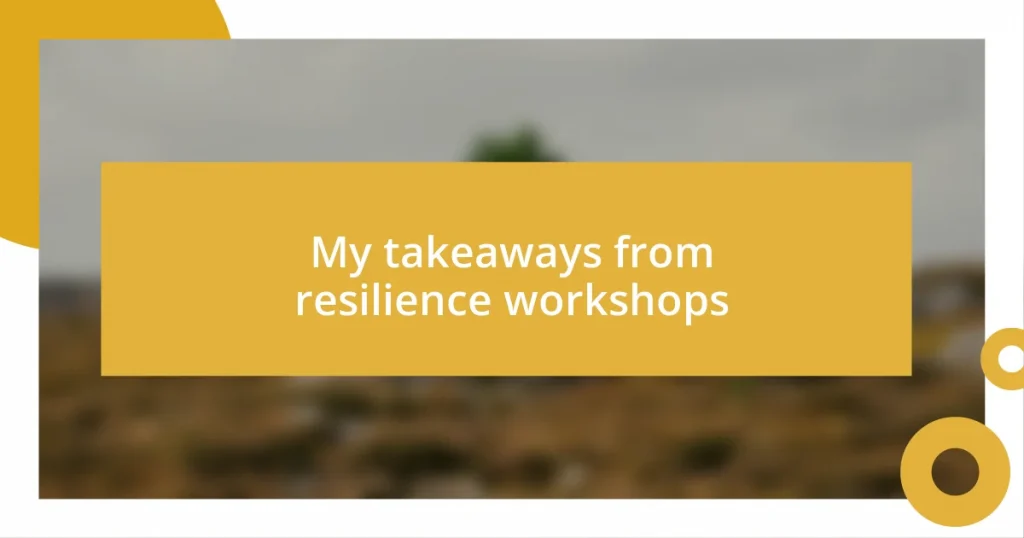Key takeaways:
- Understanding caregiver stress involves recognizing emotional and physical symptoms, such as fatigue and irritability, and acknowledging the importance of self-care.
- Effective stress relief techniques, including breathing exercises, setting boundaries, and creative outlets like journaling, can significantly improve caregivers’ well-being.
- Building a support network and incorporating self-care routines are essential strategies for caregivers to maintain balance and enhance their ability to provide compassionate care.

Understanding caregiver stress
Caregiver stress is an overwhelming emotions that can creep in quietly, often unnoticed until it becomes unmanageable. I remember a time when, amidst my daily responsibilities, I felt a dull ache in my chest that I attributed to fatigue. It wasn’t until a friend pointed out how often I looked worn out that I realized I was carrying the weight of not just my own worries but someone else’s as well. How often do we ignore the signs, thinking we can push through for the sake of those we care for?
The pressure to be constantly available and compassionate can lead to a sense of isolation, making the journey even harder. I often found myself feeling alone with my thoughts, questioning my ability to provide the best care. Have you ever felt that tug-of-war between wanting to help and feeling completely drained? That conflict is a hallmark of caregiver stress, and acknowledging these feelings is the first step toward relief.
Moreover, the emotional toll can manifest in physical symptoms too—headaches, sleepless nights, and a general sense of exhaustion all became my unwelcome companions. I vividly remember a night when I couldn’t sleep, my mind racing with everything I felt I had to do. It hit me then that taking care of myself wasn’t just a luxury; it was a necessity. Can we really offer our best to those we love if we’re running on empty?

Recognizing the signs of stress
Recognizing the signs of stress isn’t just important; it’s crucial for maintaining both your well-being and the quality of care you provide. I once brushed off my constant irritability as just a bad day, but my family thought otherwise. They pointed out that little things—like forgetting to pay the bills or snapping at my loved ones—were signaling something deeper. It made me realize that stress manifests in more ways than one might expect, and acknowledging those signs is the first step toward addressing them.
Here are some common signs of caregiver stress to look out for:
- Increased fatigue or exhaustion
- Frequent irritability or mood swings
- Withdrawal from social activities or relationships
- Difficulty sleeping or insomnia
- Physical symptoms like headaches or stomach issues
- Neglecting self-care or personal needs
- Feelings of hopelessness or helplessness
Trust me, I learned the hard way that recognizing these signs early can make a world of difference in how effectively you can support yourself and those you care for. It’s about tuning into your emotions and being honest with yourself.

Effective stress relief techniques
Effective stress relief techniques can truly transform the way we navigate caregiving. I’ve found that simple breathing exercises can be incredibly beneficial, especially during overwhelming moments. Just taking a few minutes to focus on my breath reminds me to pause and regain my composure. It’s remarkable how such a small practice can create a ripple effect of calm throughout the day.
Setting boundaries is another crucial technique that has significantly shifted my perspective. Initially, I struggled with saying “no.” It felt like I was rejecting those I cared for. However, I learned the hard way that not establishing limits only led to burnout. By consciously carving out time for myself—whether it was a leisurely walk or a quiet moment with a book—I discovered a renewed energy to devote to others. Have you ever tried tuning into your own needs first?
Incorporating creative outlets has been a game-changer for me, too. I started journaling to capture my thoughts, which became an unexpected form of therapy. It allows me to express my feelings without judgment, helping me process stress and find clarity. This technique has not only lifted the weight off my shoulders but also provided me with insights into my caregiving journey that I hadn’t recognized before. I encourage anyone feeling overwhelmed to explore their creative side—it might just be the relief you need.
| Technique | Description |
|---|---|
| Breathing Exercises | Simple techniques to focus on breath for short periods, promoting relaxation. |
| Setting Boundaries | Learning to say “no” to ensure personal time and prevent burnout. |
| Creative Outlets | Using activities like journaling to express emotions and relieve stress. |

Mindfulness practices for caregivers
Mindfulness practices have truly been a lifeline for me as a caregiver. On days when I feel completely frazzled, I’ve discovered the power of meditation, even if it’s just a quiet five minutes in my room. I remember sitting cross-legged on my bed, closing my eyes, and focusing on the sounds around me—the subtle rustling of leaves outside and the distant hum of life. What struck me is how this simple act centers me, bringing a clearer perspective on my emotions and my responsibilities.
Another mindfulness technique that I cherish is mindful walking. It might sound trivial, but my walks around the neighborhood have turned into moments of appreciation. I consciously take in my surroundings, whether it’s the vibrant colors of blooming flowers or the gentle chirping of birds. At first, I thought it was just an excuse to escape for a bit, but I realized that being present in those moments shifted my mood significantly. Have you considered how grounding yourself in nature could change your mindset?
Journaling also plays a pivotal role in my mindfulness journey. I use it to reflect on my feelings, capturing thoughts that might seem fleeting otherwise. One evening, I wrote about a challenging day; I discovered that articulating my stresses allowed me to release them. The act of handwriting my worries and joys became a therapeutic ritual, turning chaos into clarity. How often do we take the time to understand our own experiences? Embracing these practices not only helps me cope but truly enhances my ability to provide compassionate care.

Building a support network
Building a support network is something I genuinely believe every caregiver should prioritize. When I first started my caregiving journey, I felt isolated and overwhelmed. It wasn’t until I reached out to a few close friends and family that I realized the incredible value of having people who understand the unique challenges I face. I often wonder how many of us miss out on that connection simply out of a reluctance to share our struggles.
One practical step I took was to join a local caregiver support group. At first, I was apprehensive about sharing my experiences, fearing judgment. However, the moment I opened up about my struggles, I was met with nods of understanding and heartfelt stories from others in similar situations. This camaraderie built my confidence and provided a sense of belonging that is hard to replicate. Have you ever thought about how powerful it can be to share not just the burdens but also the small victories?
Now, I also make a conscious effort to check in regularly with my network. A simple text, a phone call, or even a coffee catch-up can be incredibly revitalizing. I once had an enlightening conversation with a fellow caregiver who shared how they manage time for self-care amidst the chaos of responsibilities. It sparked ideas for me! By sharing tips and recipes for stress relief, we not only support each other emotionally but build an enriching toolkit for navigating our caregiving roles together.

Incorporating self-care routines
Incorporating self-care routines has been a game changer for me. I realized that carving out just 10 minutes a day for a nourishing activity, like enjoying a cup of herbal tea while listening to soothing music, helps ground my day. It’s surprising how those few moments can transform my mood, like flicking a switch from chaos to calm. Have you ever noticed how something as simple as a warm drink can refuel your spirit?
I also make time for physical activity, which I underestimated at first. I remember a particularly exhausting week when I decided to try a short yoga session at home. The gentle stretches not only eased my tension but also lifted my spirits. It made me think about how much I’ve overlooked the power of movement in my life. Honestly, it’s crazy how a few minutes of physical engagement can act as a reset button for overwhelming stress.
Setting boundaries is another crucial aspect of my self-care routine. One day, I found myself saying “yes” to every request, thinking I could handle it all, only to end up feeling drained. That was my wake-up call! I began to prioritize my needs by learning to say “no” when necessary. By protecting my time, I created space for activities that truly rejuvenate me, allowing me to be present—not just for myself but for those I care for. Can we really give our best if we’re operating on empty?

Setting boundaries for healthy caregiving
Setting healthy boundaries has been a transformative experience in my caregiving journey. I remember the situation when I initially struggled to manage my time, always saying “yes” to additional requests, which ultimately led to burnout. It struck me one evening, as I sat exhausted on the couch, that if I continued this way, I wouldn’t be able to give my loved ones the care they truly deserved. Learning to set those boundaries was like taking control of my life back.
One of the most practical steps I implemented was designating specific hours for caregiving and personal time. I found that by scheduling my day, I created a structured environment that allowed me to excel in both roles without feeling overwhelmed. For instance, I started informing my family about my “quiet hours,” which is my time to recharge, whether it’s diving into a good book or simply enjoying silence. I often ask myself, “How can I be fully present if I don’t take time for me?”
Through this journey, I’ve learned that communicating these boundaries is essential. I had a heart-to-heart conversation with my loved ones about my limits, and to my surprise, they were incredibly understanding. This open dialogue not only helped to ease my anxiety but also fostered respect for the boundaries I set. It’s empowering to realize that taking care of myself ultimately enhances my ability to care for others. Don’t you think establishing boundaries is a step towards better caregiving, not just for us but for those we love?















